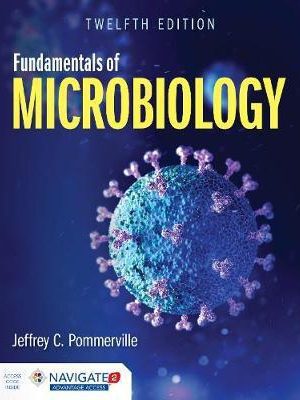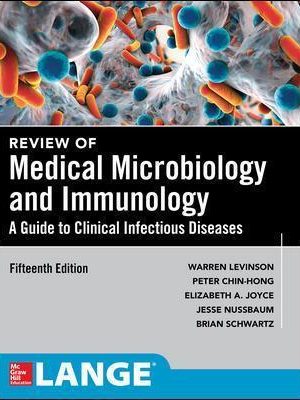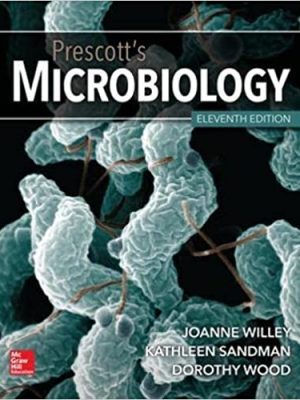Prescott’s Microbiology 11th Edition
Prescott’s Microbiology Eleventh Edition:
More Details
Cover
Prescott’s Microbiology
Copyright
Brief Contents
About the Authors
Digital Tools for Your Success
A Modern Approach to Microbiology
Student-Friendly Organization
List of Content Changes
Lab Tools for Your Success
Acknowledgements
Contents
Part One Introduction to Microbiology
1 The Evolution of Microorganisms and Microbiology
Micro Focus:The Microbial Universe
1.1 Members of the Microbial World
1.2 Microbes Have Evolved and Diversified for Billions of Years
1.3 Microbiology Advanced as New Tools for Studying Microbes Were Developed
1.4 Microbiology Encompasses Many Subdisciplines
2 Microscopy
Micro Focus:Anthrax Bioterrorism Attack
2.1 Lenses Create Images by Bending Light
2.2 There Are Several Types of Light Microscopes
2.3 Staining Specimens Helps to Visualize and Identify Microbes
2.4 Electron Microscopes Use Beams of Electrons to Create Highly Magnified Images
2.5 Scanning Probe Microscopy Can Visualize Molecules and Atoms
3 Bacterial Cell Structure
Micro Focus:Hooking Up
3.1 Use of the Term “Prokaryote” Is Controversial
3.2 Bacteria Are Diverse but Share Some Common Features
3.3 Bacterial Plasma Membranes Control What Enters and Leaves the Cell
3.4 There Are Two Main Types of Bacterial Cell Walls
Microbial Diversity & Ecology 3.1
Gram Positive and Gram Negative or Monoderms and Diderms?
3.5 The Cell Envelope Often Includes Layers Outside the Cell Wall
3.6 The Bacterial Cytoplasm Is More Complex than Once Thought
3.7 Many Bacteria Have External Structures Used for Attachment and Motility
3.8 Bacteria Move in Response to Environmental Conditions
3.9 Bacterial Endospores Are a Survival Strategy
4 Archaeal Cell Structure
Micro Focus:Cows and Buffaloes and Sheep, Oh My!
4.1 Archaea Are Diverse but Share Some Common Features
4.2 Archaeal Cell Envelopes Are Structurally Diverse
4.3 Archaeal Cytoplasm Is Similar to Bacterial Cytoplasm
4.4 Many Archaea Have External Structures Used for Attachment and Motility
5 Eukaryotic Cell Structure
Micro Focus:Red Means Dead
5.1 Eukaryotic Cells Are Diverse but Share Some Common Features
5.2 Eukaryotic Cell Envelopes
5.3 The Eukaryotic Cytoplasm Contains a Cytoskeleton and Organelles
5.4 Several Organelles Function in the Secretory and Endocytic Pathways
5.5 The Nucleus and Ribosomes Are Involved in Genetic Control of the Cell
5.6 Mitochondria, Related Organelles, and Chloroplasts Are Involved in Energy Conservation
Microbial Diversity & Ecology 5.1
There Was an Old Woman Who Swallowed a Fly
5.7 Many Eukaryotic Microbes Have External Structures Used for Motility
5.8 Comparison of Bacterial, Archaeal, and Eukaryotic Cells
6 Viruses and Other Acellular Infectious Agents
Micro Focus:Mustard, Ketchup, and Viruses?
6.1 Viruses Are Acellular
6.2 Virion Structure Is Defined by Capsid Symmetry and Presence or Absence of an Envelope
6.3 Viral Life Cycles Have Five Steps
6.4 There Are Several Types of Viral Infections
6.5 Cultivation and Enumeration of Viruses
6.6 Viroids and Satellites: Nucleic Acid-Based Subviral Agents
6.7 Prions Are Composed Only of Protein
Part Two Microbial Nutrition, Growth, and Control
7 Bacterial and Archaeal Growth
Micro Focus:How Low Can You Go?
7.1 Most Bacteria and Archaea Reproduce by Binary Fission
7.2 Bacterial Cell Cycles Can Be Divided into Three Phases
7.3 Archaeal Cell Cycles Are Unique
7.4 Growth Curves Consist of Five Phases
7.5 Environmental Factors Affect Microbial Growth
7.6 Microbial Growth in Natural Environments
7.7 Laboratory Culture of Cellular Microbes Requires Media and Conditions That Mimic the Normal Habitat of a Microbe
7.8 Microbial Population Size Can Be Measured Directly or Indirectly
7.9 Chemostats and Turbidostats Are Used for Continuous Culture of Microorganisms
8 Control of Microorganisms in the Environment
Micro Focus:Keeping Infection at Bay
8.1 Microbial Growth and Replication: Targets for Control
8.2 The Pattern of Microbial Death Mirrors the Pattern of Microbial Growth
8.3 Mechanical Removal Methods Rely on Barriers
Microbial Diversity & Ecology 8.1
The Cleanest Place on Earth?
8.4 Physical Control Methods Alter Microorganisms to Make Them Nonviable
8.5 Microorganisms Are Controlled with Chemical Agents
8.6 Antimicrobial Agents Must Be Evaluated for Effectiveness
8.7 Microorganisms Can Be Controlled by Biological Methods
9 Antimicrobial Chemotherapy
Micro Focus:The Story of Syphilis Treatment
9.1 Antimicrobial Chemotherapy Evolved from Antisepsis Efforts
9.2 Antimicrobial Drugs Have Selective Toxicity
9.3 Antimicrobial Activity Can Be Measured by Specific Tests
9.4 Antibacterial Drugs
9.5 Antiviral Drugs
9.6 Antifungal Drugs
9.7 Antiprotozoan Drugs
9.8 Antimicrobial Drug Resistance Is a Public Health Threat
Part Three Microbial Metabolism
10 Introduction to Metabolism
Micro Focus:Flushed Away
10.1 Metabolism: Important Principles and Concepts
10.2 ATP: The Major Energy Currency of Cells
10.3 Redox Reactions: Reactions of Central Importance in Metabolism
10.4 Electron Transport Chains: Sets of Sequential Redox Reactions
10.5 Biochemical Pathways: Sets of Linked Chemical Reactions
10.6 Enzymes and Ribozymes Speed Up Cellular Chemical Reactions
10.7 Metabolism Must Be Regulated to Maintain Homeostasis
11 Catabolism: Energy Release and Conservation
Micro Focus:The Richest Hill on Earth
11.1 Metabolic Diversity and Nutritional Types
11.2 There Are Three Chemoorganotrophic Fueling Processes
11.3 Aerobic Respiration Can Be Divided into Three Steps
11.4 Glucose to Pyruvate: The First Step
11.5 Pyruvate to Carbon Dioxide (Step 2) Is Accomplished by the Tricarboxylic Acid Cycle
11.6 Electron Transport and Oxidative Phosphorylation (Step 3) Generate the Most ATP
11.7 Anaerobic Respiration Uses the Same Three Steps as Aerobic Respiration
11.8 Fermentation Does Not Involve an Electron Transport Chain
11.9 Catabolism of Organic Molecules Other Than Glucose
11.10 Chemolithotrophy: “Eating Rocks”
11.11 Flavin-Based Electron Bifurcation
11.12 Phototrophy
12 Anabolism: The Use of Energy in Biosynthesis
Micro Focus:Building Penicillin
12.1 Principles Governing Biosynthesis
12.2 Precursor Metabolites: Starting Molecules for Biosynthesis
12.3 CO2 Fixation: Reduction and Assimilation of CO2 Carbon
12.4 Synthesis of Carbohydrates
12.5 Synthesis of Amino Acids Consumes Many Precursor Metabolites
12.6 Synthesis of Purines, Pyrimidines, and Nucleotides
12.7 Lipid Synthesis
Part Four Microbial Molecular Biology and Genetics
13 Bacterial Genome Replication and Expression
Micro Focus:Making Code
13.1 Experiments Using Bacteria and Viruses Demonstrated that DNA Is the Genetic Material
13.2 Nucleic Acid and Protein Structure
13.3 DNA Replication in Bacteria
13.4 Bacterial Genes Consist of Coding Regions and Other Sequences Important for Gene Function
13.5 Transcription in Bacteria
13.6 The Genetic Code Consists of Three-Letter “Words”
13.7 Translation in Bacteria
13.8 Protein Maturation and Secretion
14 Regulation of Bacterial Cellular Processes
Micro Focus:Light Show
14.1 Bacteria Use Many Regulatory Options
14.2 Regulation of Transcription Initiation Saves Considerable Energy and Materials
14.3 Attenuation and Riboswitches Stop Transcription Prematurely
14.4 Riboswitches and Small RNAs Control Translation
14.5 Mechanisms Used for Global Regulation
14.6 Bacteria Combine Several Regulatory Mechanisms to Control Complex Cellular Processes
15 Eukaryotic and Archaeal Genome Replication and Expression
Micro Focus:Plastics: Brought to You by Microbes
15.1 Why Consider Eukaryotic and Archaeal Genetics Together?
15.2 DNA Replication: Similar Overall, but with Different Replisome Proteins
15.3 Transcription
15.4 Translation and Protein Maturation and Localization
15.5 Regulation of Cellular Processes
16 Mechanisms of Genetic Variation
Micro Focus:Manure Happens
16.1 Mutations: Heritable Changes in a Genome
16.2 Detection and Isolation of Mutants
16.3 DNA Repair Maintains Genome Stability
16.4 Microbes Use Mechanisms Other than Mutation to Create Genetic Variability
16.5 Transposable Elements Move Genes Within and Between DNA Molecules
16.6 Bacterial Conjugation Requires Cell-Cell Contact
16.7 Bacterial Transformation Is the Uptake of Free DNA from the Environment
16.8 Transduction Is Virus-Mediated DNA Transfer
16.9 Evolution in Action: The Development of Antibiotic Resistance in Bacteria
17 Microbial DNA Technologies
Micro Focus:Spinning Stronger Silk
17.1 Key Discoveries Led to the Development of DNA Cloning Technology
Techniques & Applications 17.1
Gel Electrophoresis
Techniques & Applications 17.2
How to Build a Microorganism
17.2 Polymerase Chain Reaction Amplifies Targeted DNA
17.3 Genomic Libraries: Cloning Genomes in Pieces
17.4 Expressing Foreign Genes in Host Cells
17.5 Cas9 Nuclease Is a Precise Tool for Genome Editing
18 Microbial Genomics
Micro Focus:“Synthetic Life”: Oxymoron or the Future?
18.1 DNA Sequencing Methods
18.2 Genome Sequencing
18.3 Metagenomics Provides Access to Uncultured Microbes
18.4 Bioinformatics: What Does the Sequence Mean?
18.5 Functional Genomics Links Genes to Phenotype
18.6 Systems Biology: Making and Testing Complex Predictions
18.7 Comparative Genomics
Part Five The Diversity of the Microbial World
19 Microbial Taxonomy and the Evolution of Diversity
Micro Focus:Scientists Query: “Is the Microbial Universe Expanding?”
19.1 Microbial Taxonomy Is Based on the Comparison of Multiple Traits
19.2 Taxonomic Ranks Provide an Organizational Framework
19.3 Microbial Taxonomy and Phylogeny Are Largely Based on Molecular Characterization
19.4 Phylogenetic Trees Illustrate Evolutionary Relationships
19.5 Evolutionary Processes and the Concept of a Microbial Species Inspire Debate
19.6 Bergey’s Manual of Systematics of Archaea and Bacteria
20 Archaea
Micro Focus:Methanogenic Archaea Fuel Domestic Energy Debate
20.1 Overview of Archaea
20.2 Proteoarchaeota, or TACK Superphylum
20.3 Phylum Euryarchaeota: Methanogens, Haloarchaea, and Others
21 Nonproteobacterial Gram-Negative Bacteria
Micro Focus:Fuel From Food Waste
21.1 Aquificae and Thermotogae Are Ancient Bacterial Lineages
21.2 Deinococcus-Thermus Includes Radiation-Resistant Bacteria
21.3 Class Mollicutes, Phylum Tenericutes: Bacteria That Lack Cell Walls
21.4 Photosynthetic Bacteria Are Diverse
21.5 Superphylum Planctomycetes- Verrucomicrobia-Chlamydiae: Atypical Cell Division
21.6 Phylum Spirochaetes: Bacteria with a Corkscrew Morphology
21.7 Phylum Bacteroidetes Includes Important Gut Microbiota
21.8 Phylum Fusobacteria: Commensal Anaerobes
22 Proteobacteria
Micro Focus:Bison and Brucellosis Spark Controversy
22.1 Class Alphaproteobacteria Includes Many Oligotrophs
22.2 Class Betaproteobacteria Includes Chemoheterotrophs and Chemolithotrophs
Microbial Diversity & Ecology 22.1
Acid Mine Drainage
22.3 Class Gammaproteobacteria Is the Largest Bacterial Class
22.4 Class Deltaproteobacteria Includes Chemoheterotrophic Anaerobes and Predators
22.5 Class Epsilonproteobacteria Ranges from Pathogens to Deep-Sea Bacteria
23 Gram-Positive Bacteria
Micro Focus:Antibiotic Production: Is It Actually Bacterial Chitchat?
23.1 Class Actinobacteria
23.2 Class Bacilli: Aerobic Endospore-Forming Bacteria
23.3 Class Clostridia: Anaerobic Endospore- Forming Bacteria
23.4 Class Negativicutes: Gram-Positive Bacteria with Outer Membranes
24 Protists
Micro Focus:Sustainable Farming Practiced by Amoebae
24.1 Protist Diversity Reflects Broad Phylogeny
24.2 Supergroup Excavata: Primitive Eukaryotes
24.3 Supergroup Amoebozoa Includes Protists with Pseudopodia
24.4 Supergroup SAR: Protists of Global Importance
24.5 Supergroup Archaeplastida Includes “Green Algae”
25 Fungi
Micro Focus:The Complex Story of Caterpillar Fungus
25.1 Fungal Biology Reflects Vast Diversity
25.2 Chytridiomycetes Produce Motile Spores
25.3 Zygomycetes: Fungi with Coenocytic Hyphae
25.4 Glomeromycota Are Mycorrhizal Symbionts
25.5 Ascomycota Includes Yeasts and Molds
25.6 Basidiomycota Includes Mushrooms and Plant Pathogens
Disease 25.1
White-Nose Syndrome Is Decimating North American Bat Populations
25.7 Microsporidia Are Intracellular Parasites
26 Viruses
Micro Focus:Disrupting the Viral Life Cycle
26.1 Virus Phylogeny Is Difficult to Establish
26.2 Double-Stranded DNA Viruses Infect All Cell Types
26.3 Single-Stranded DNA Viruses Use a Double-Stranded Intermediate in Their Life Cycles
26.4 Double-Stranded RNA Viruses: RNA-Dependent RNA Polymerase Replicates the Genome and Synthesizes mRNA
26.5 Plus-Strand RNA Viruses: Genomes That Can Be Translated upon Entry
26.6 Minus-Strand RNA Viruses: RNA- Dependent RNA Polymerase Is Part of the Virion
26.7 Retroviruses: Plus-Strand Viruses That Use Reverse Transcriptase in Their Life Cycles
26.8 Reverse Transcribing DNA Viruses
Part Six Ecology and Symbiosis
27 Microbial Interactions
Micro Focus:Microbes in Community
27.1 Many Types of Microbial Interactions Exist
27.2 Mutualism and Cooperation Are Two-Way Interactions
Microbial Diversity & Ecology 27.1
Wolbachia pipientis: The World’s Most Infectious Microbe?
27.3 Commensalism and Amensalism Are One-Way Interactions
27.4 Antagonistic Interactions Characterize Predation, Parasitism, and Competition
28 Biogeochemical Cycling and Global Climate Change
Micro Focus:Global Climate Change; Global Infectious Disease Change?
28.1 Biogeochemical Cycling Sustains Life on Earth
28.2 Global Climate Change: Biogeochemical Cycling Out of Balance
29 Methods in Microbial Ecology
Micro Focus:Scientists Search for Intraterrestrial Life—and Find It
29.1 Microbial Biology Relies on Cultures
29.2 Genetic Methods Are Used to Assess Microbial Diversity
29.3 Assessment of Microbial Community Activity Relies on Biochemistry and Genetics
30 Microorganisms in Marine and Freshwater Ecosystems
Micro Focus:Ocean Death Coming Soon to a Coast Near You
30.1 Water Is the Largest Microbial Habitat
30.2 Microorganisms in Marine Ecosystems
30.3 Microorganisms in Freshwater Ecosystems
31 Microorganisms in Terrestrial Ecosystems
Micro Focus:Bread for a Hungry World
31.1 Soils Are an Important Microbial Habitat
31.2 Diverse Microorganisms Inhabit Soil
31.3 Microbe-Plant Interactions Can Be Positive, Negative, or Neutral
31.4 The Subsurface Biosphere Is Vast
Part Seven Pathogenicity and Host Response
32 Innate Host Resistance
Micro Focus:Supersize Me!
32.1 Immunity Arises from Innate Resistance and Adaptive Defenses
32.2 Innate Resistance Starts with Barriers
32.3 Innate Resistance Relies on Chemical Mediators
32.4 Each Type of Innate Immune Cell Has a Specific Function
32.5 Organs and Tissues of the Immune System Are Sites of Host Defense
32.6 Phagocytosis Destroys Invaders
32.7 Inflammation Unites All Components of Immunity
33 Adaptive Immunity
Micro Focus:Killing Cancer, Immunologically
33.1 Adaptive Immunity Relies on Recognition and Memory
33.2 Antigens Elicit Immunity
33.3 Adaptive Immunity Can Be Earned or Borrowed
33.4 Recognition of Foreignness Is Critical for a Strong Defense
33.5 T Cells Are Critical for Immune Function
33.6 B Cells Make Antibodies
33.7 Antibodies Bind Specific 3-D Antigens
Techniques & Applications 33.1
Monoclonal Antibody Therapy
33.8 Antibodies Doom Antigens
33.9 Immune Tolerance Is a Must
33.10 The Immune System Can Malfunction
34 The Microbe-Human Ecosystem
Micro Focus:Embrace Your Gut Flora
34.1 Humans Are Holobionts
34.2 The Microbiome Develops from Birth to Adulthood
34.3 A Functional Core Microbiome Is Required for Human Homeostasis
34.4 Many Diseases Have a Connection with Dysbiosis
34.5 Microbiome Manipulation Can Be Therapeutic
35 Infection and Pathogenicity
Micro Focus:Dodging the Bullet
35.1 The Process of Infection
35.2 Transmission and Entry into the Host
Historical Highlights 35.1
The First Indications of Person-to-Person Spread of an Infectious Disease
35.3 Surviving the Host Defenses
35.4 Damage to the Host
Part Eight Microbial Diseases, Detection, and Their Control
36 Epidemiology and Public Health Microbiology
Micro Focus:Practice What You Preach
36.1 Epidemiology Is an Evidence-Based Science
Historical Highlights 36.1
The History of Public Health in the United States
Historical Highlights 36.2
John Snow, the First Epidemiologist
36.2 Epidemiology Is Rooted in Well-Tested Methods
36.3 Infectious Disease Is Revealed Through Patterns Within a Population
Historical Highlights 36.3
“Typhoid Mary”
36.4 Infectious Diseases and Pathogens Are Emerging and Reemerging
36.5 Healthcare Facilities Harbor Infectious Agents
36.6 Coordinated Efforts Are Required to Prevent and Control Epidemics
Historical Highlights 36.4
The First Immunizations
36.7 Bioterrorism Readiness Is an Integral Component of Public Health Microbiology
Historical Highlights 36.5
1346—Early Biological Warfare Attack
37 Clinical Microbiology and Immunology
Micro Focus:Ebola and Global Health Security
37.1 The Clinical Microbiology Laboratory Detects Infectious Agents and Protects Its Workers
37.2 Identification of Microorganisms from Specimens
37.3 Immune Responses Can Be Exploited to Detect Infections
38 Human Diseases Caused by Viruses and Prions
Micro Focus:Remembering HIV/AIDS
38.1 Viruses Can Be Transmitted by Airborne Routes
38.2 Arthropods Can Transmit Viral Diseases
38.3 Direct Contact Diseases Can Be Caused by Viruses
38.4 Food and Water Are Vehicles for Viral Diseases
Historical Highlights 38.1
A Brief History of Polio
38.5 Zoonotic Diseases Arise from Human-Animal Interactions
38.6 Prion Proteins Transmit Disease
39 Human Diseases Caused by Bacteria
Micro Focus:The Plague Family Tree
39.1 Bacteria Can Be Transmitted by Airborne Routes
39.2 Arthropods Can Transmit Bacterial Diseases
39.3 Direct Contact Diseases Can Be Caused by Bacteria
Disease 39.1
Syphilis and the Tuskegee Study
Disease 39.2
Biofilms
39.4 Food and Water Are Vehicles for Bacterial Diseases
Techniques & Applications 39.3
Clostridial Toxins as Therapeutic Agents: Benefits of Nature’s Most Toxic Proteins
39.5 Zoonotic Diseases Arise from Human-Animal Interactions
39.6 Opportunistic Diseases Can Be Caused by Bacteria
40 Human Diseases Caused by Fungi and Protists
Micro Focus:Mushrooms of Death
40.1 Relatively Few Fungi and Protists Are Human Pathogens
40.2 Fungi Can Be Transmitted by Airborne Routes
40.3 Arthropods Can Transmit Protozoal Disease
Disease 40.1
A Brief History of Malaria
40.4 Direct Contact Diseases Can Be Caused by Fungi and Protists
40.5 Food and Water Are Vehicles of Protozoal Diseases
40.6 Opportunistic Diseases Can Be Caused by Fungi and Protists
Part Nine Applied Microbiology
41 Microbiology of Food
Micro Focus:The Art, Science, and Genetics of Brewing Beer
41.1 Microbial Growth Can Cause Food Spoilage
41.2 Various Methods Are Used to Control Food Spoilage
41.3 Food-Borne Disease Outbreaks
41.4 Detection of Food-Borne Pathogens Requires Government-Industry Cooperation
41.5 Microbiology of Fermented Foods: Beer, Cheese, and Much More
Techniques & Applications 41.1
Chocolate: The Sweet Side of Fermentation
42 Biotechnology and Industrial Microbiology
Micro Focus:Where Are the New Antibiotics?
42.1 Microbes Are the Source of Many Products of Industrial Importance
42.2 Biofuel Production Is a Dynamic Field
42.3 Growing Microbes in Industrial Settings Presents Challenges
42.4 Production Strains Maximize Output of Industrially Important Compounds
42.5 Agricultural Biotechnology Relies on a Plant Pathogen
42.6 Some Microbes Are Products
43 Applied Environmental Microbiology
Micro Focus:Deepwater Horizon Oil Consumed by Microbes
43.1 Purification and Sanitary Analysis Ensure Safe Drinking Water
43.2 Wastewater Treatment Maintains Human and Environmental Health
43.3 Microbial Fuel Cells: Batteries Powered by Microbes
43.4 Biodegradation and Bioremediation Harness Microbes to Clean the Environment
Appendix 1 A Review of the Chemistry of Biological Molecules
Appendix 2 Common Metabolic Pathways
Appendix 3 Microorganism Pronunciation Guide
Glossary
Index



























 Dentistry
Dentistry
Reviews
There are no reviews yet.